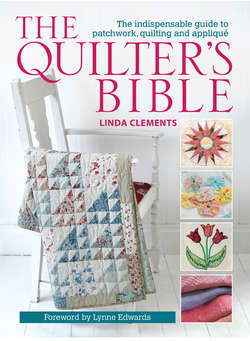Читать книгу The Quilter's Bible - Linda - Страница 12
На сайте Литреса книга снята с продажи.
Sewing Tools
ОглавлениеThese are the tools you will probably use the most. Use the best you can afford and experiment to find the types that suit you.
• Needles (1) – There are many types of needle for machine and hand sewing, each designed for specific types of thread or fabric. Choose the needle to suit the task – see Using the Right Needle for more advice.
• Pins (2) – Beginners will be amazed at the different types of pins available – there are glass-headed pins, plastic-headed pins, flower-headed pins, silk pins, appliqué pins and even sequin pins! For general patchwork and quilting, all you really need are pins that are sharp and fine, can be easily sewn over by a sewing machine and where the heads can be seen easily. Glass-headed pins don’t melt with the heat of a hot iron, while flower-headed pins are easy to pick up. Longer pins are useful for securing the layers of a quilt. Having several pincushions around your work area will help keep pins under control, as will magnets (see Magnets).
• Thimble (3) – You will need a thimble (or several) to protect your fingers as you sew and quilt. Various types are available, including those made from metal, leather and plastic. Choose one with deep indentations so the end of the needle doesn’t slip off the thimble. Thimbles may be closed-ended or open-ended, for long nails. Finger guards help protect the underneath finger as you quilt.
• Needle threader (4) – A needle threader may not always be needed but fatigue or age can make threading a needle awkward at times.
• Safety pins (5) – Safety pins are primarily used to fix the layers of a quilt together, ready for quilting. Safety pins come in various guises. There are straight ones, curved ones and those with different finishes, including anodized and brass. Choose safety pins that are sharp, rust proof and about 1in (2.5cm) long. Curved pins can make pin-tacking (basting) a quilt easier.
• Wax block (6) – Beeswax or silicone wax is available in a block form and is used to coat threads to help prevent tangling and knotting. Threads are available that are already silicone coated.
• Fusible bias tape (7) –Bias tape is used in stained-glass appliqué and Celtic appliqué. Commercially made bias tape with a fusible web backing allows easy fusing to fabric. Fusible web for gluing one fabric to another is also available in reels.
• Fabric glue – Glues suitable for fabric come in liquid, solid (glue stick) and spray form and can be used for permanent hold for attaching braids and embellishments, as a temporary adhesive for tacking (basting) fabrics together, or for holding the layers of a quilt together prior to quilting.
• Piping cord – This will be needed for piped edges and for corded Italian quilting. It is available in different widths and also in a fusible format. Quilting wool is also useful for corded quilting.
• Polyester stuffing – This may also be called toy stuffing and fiberfill and is used for puffed patchwork, three-dimensional appliqué and stuffed quilting.
• Hoops and frames – These are available in different types and sizes, hand-held and floor-standing, and are used to keep fabric taut. They are useful for embellishing work with hand embroidery and for quilting.
• Freezer paper – This has a shiny, plastic-coated side that will stick to fabric when ironed, and can be removed and reapplied several times. It is excellent for appliqué and for marking quilting designs.
• Sewing machine – Any sewing machine that has a zigzag function and a variable stitch length can be used for patchwork, appliqué and quilting. See Sewing Machine Basics for more advice.
